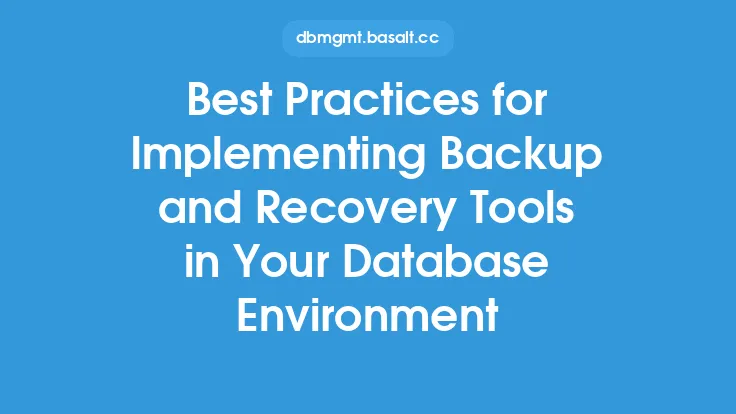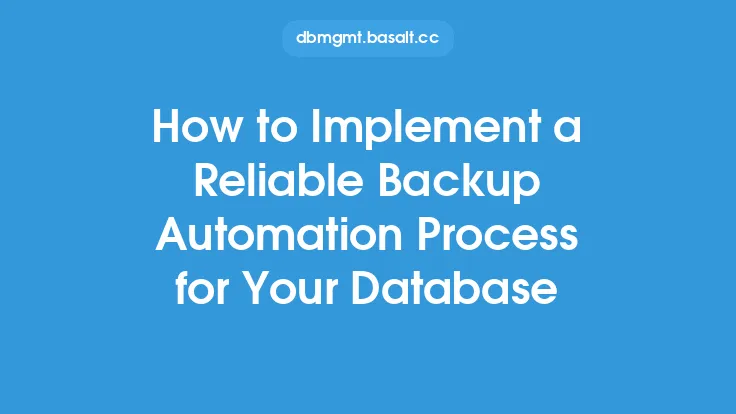When it comes to database management, having a disaster recovery plan in place is crucial to ensure business continuity and minimize data loss in the event of a disaster. A well-crafted disaster recovery plan can help organizations quickly recover from disasters, such as natural disasters, hardware failures, or cyber-attacks, and get back to normal operations. However, creating a disaster recovery plan can be a complex and costly process, which is why it's essential to create a cost-effective plan that meets the organization's needs.
Understanding the Cost Factors
To create a cost-effective disaster recovery plan, it's essential to understand the cost factors involved. The cost of a disaster recovery plan can be broken down into several components, including hardware, software, personnel, and maintenance costs. Hardware costs include the cost of purchasing and maintaining backup servers, storage devices, and other equipment. Software costs include the cost of backup and recovery software, as well as any licensing fees. Personnel costs include the cost of hiring and training IT staff to manage the disaster recovery plan. Maintenance costs include the cost of regularly testing and updating the plan to ensure it remains effective.
Identifying Cost-Saving Opportunities
There are several cost-saving opportunities that organizations can take advantage of when creating a disaster recovery plan. One of the most significant cost-saving opportunities is to use cloud-based backup and recovery services. Cloud-based services can provide a cost-effective alternative to traditional on-premise backup and recovery solutions, as they eliminate the need for hardware and software purchases. Additionally, cloud-based services can provide scalability and flexibility, allowing organizations to easily increase or decrease their backup and recovery capacity as needed.
Leveraging Open-Source Solutions
Another cost-saving opportunity is to leverage open-source backup and recovery solutions. Open-source solutions can provide a cost-effective alternative to commercial backup and recovery software, as they are often free or low-cost. Additionally, open-source solutions can provide a high degree of customization and flexibility, allowing organizations to tailor their backup and recovery plan to meet their specific needs.
Implementing a Tiered Recovery Plan
Implementing a tiered recovery plan is another way to create a cost-effective disaster recovery plan. A tiered recovery plan involves prioritizing data and applications based on their business criticality and recovery time objectives. This allows organizations to focus their recovery efforts on the most critical data and applications, while less critical data and applications can be recovered at a later time. By prioritizing recovery efforts, organizations can reduce the cost and complexity of their disaster recovery plan.
Using Automation and Orchestration
Using automation and orchestration tools is another way to create a cost-effective disaster recovery plan. Automation and orchestration tools can help streamline the recovery process, reducing the need for manual intervention and minimizing the risk of human error. Additionally, automation and orchestration tools can provide real-time monitoring and reporting, allowing organizations to quickly identify and respond to disasters.
Conducting Regular Testing and Maintenance
Conducting regular testing and maintenance is essential to ensure the effectiveness of a disaster recovery plan. Regular testing and maintenance can help identify areas for improvement and ensure that the plan remains up-to-date and relevant. Additionally, regular testing and maintenance can help reduce the cost of recovery by identifying and addressing potential issues before they become major problems.
Measuring the Cost-Effectiveness of a Disaster Recovery Plan
Measuring the cost-effectiveness of a disaster recovery plan is essential to ensure that it is providing the desired level of protection at an acceptable cost. There are several metrics that organizations can use to measure the cost-effectiveness of their disaster recovery plan, including recovery time objectives, recovery point objectives, and return on investment. By regularly measuring and evaluating these metrics, organizations can identify areas for improvement and make adjustments to their disaster recovery plan as needed.
Best Practices for Creating a Cost-Effective Disaster Recovery Plan
There are several best practices that organizations can follow to create a cost-effective disaster recovery plan. These include identifying and prioritizing critical data and applications, using cloud-based backup and recovery services, leveraging open-source solutions, implementing a tiered recovery plan, using automation and orchestration tools, and conducting regular testing and maintenance. By following these best practices, organizations can create a cost-effective disaster recovery plan that meets their needs and provides the desired level of protection.
Conclusion
Creating a cost-effective disaster recovery plan is essential to ensure business continuity and minimize data loss in the event of a disaster. By understanding the cost factors involved, identifying cost-saving opportunities, and implementing a tiered recovery plan, organizations can create a disaster recovery plan that meets their needs and provides the desired level of protection. Additionally, by leveraging open-source solutions, using automation and orchestration tools, and conducting regular testing and maintenance, organizations can reduce the cost and complexity of their disaster recovery plan. By following these best practices and regularly measuring and evaluating the cost-effectiveness of their disaster recovery plan, organizations can ensure that their plan remains effective and provides the desired level of protection at an acceptable cost.





